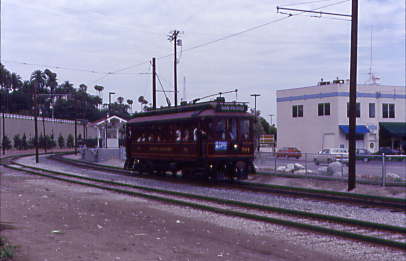
The Pacific Electric, Southern California's leading passenger rail carrier, reached San Pedro via Dominquez from Wilmington on July 5, 1905. This line used the famous bascule bridge to reach San Pedro and ran from Wilmington. On July 25, 1910, a PE line from Long Beach reached San Pedro and lasted until January 2, 1949. A PE line via Torrance reached the Port City on March 19, 1912 and lasted until January 15, 1940. PE also had some local lines out of there, namely, the Port Fermin Line at 2.33 miles ran from 1911 to 1934, the La Ramba Line at 1.52 miles ran from 1905 to 1938, the 14th Street line at 1.88 miles ran from 1911 to 1915 and the San Pedro Outer Harbor Line, at 0.18 miles, ran from 1911 to 1916. The Downtown San Pedro Pacific Electric station was located at 6th and Harbor Drive. The PE Line to San Pedro, which survived the longest, was the San Pedro via Dominquez Line, with its last day of service on December 7, 1958.
Jump to 1995, when a Blue Ribbon Task Force appointed by the Board of Harbor Commissioners proposed a rail line to link the "String of Pearls" attractions along San Pedro's Waterfront. In 1998, the Pacific Corridor Citizens Advisory Committee recommended a passenger rail connection between the Cruise Ship terminal and 22nd Street, the site of future development. Stops would also be at 6th Street, Downtown and Port O'Call Village.
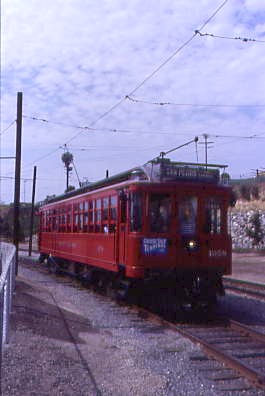
The cars to be used on this future 1.5 mile waterfront rail line included car 1058, a vintage Red Car, that began its life as a Pacific Electric 950-Class car being built as a standard wooden car 953 in 1907. The car was found after its retirement in 1950 in very bad shape at a water heating company in Compton by Richard Fellows. He saved the car and moved it to his boat yard, which was next to National Metals on Terminal Island in those days. Richard liked the PE 1000-series cars so he lengthened the frame to restore it as PE 1058, one number higher than the last 1000 car built.
Fellows wanted to run it on the streets as a bus so he added four rubber tires, a gasoline engine and a brake system. The car's deadmans pedal became the accelerator, the air valves came from a PE Blimp and the BG VE5 Universal Valve came from a New York City subway car that was rebuilt
A few years passed before Richard drowned off Huntington Beach in 1997, ending the life of a very important player in the story. The car was moved to storage in Vernon, where Richard also had collected the body and parts of PE 524, PE 655 and PE 950. Through an auction, PE 524 and 950 went to the Orange Empire Railway Museum in Perris, California. Later, Mrs. Fellows donated PE 655 to the OERM. Moving ahead again to 1998, Bob Henry, the Port's Project Manager "made one hell of a sales pitch" to acquire 1058 for the future service on the Waterfront Streetcar Line.
1058 was taken to Wilmington where FMN Roger Fruerhing was contacted to return the bus to a rail car. He managed to get motors from Japan with parts from the locomotive builder Baldwin. One General Electric motor was received with three excellent Japanese copies. They replaced the spoke wheels with AAR Wheels from ABC Rail in Palmdale and the air brakes 26R is of standard cab car design and the compressor is a Wabco New York City subway model. The new PE 1058 was painted in "Pacific Electric Red" which was adopted by the PE in 1939. The woods used were mahogany on the interior, poplar for the exterior panelling and ash for the seats. 1058 is 55 feet, seven inches long and weighs 80,000 lbs. It seats 54 with room for 78 passengers standing and will be used mainly for a spare, but will be available for charter services and special operations.
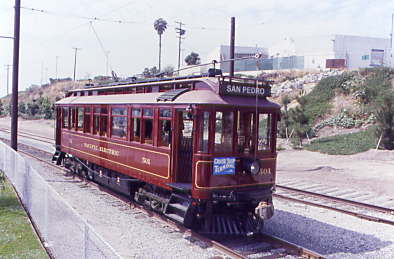
The two replica cars, 500 and 501, were built from scratch from the ground up. 501 was completed in time for the opening day trips, while 500 will be completed sometime in the next couple months if all goes according to plan. They are based on drawings of the PE 500-Class cars that ran from 1902 to 1930. The skilled craftsman from the Port of Los Angeles Construction and Maintenance Division built these two beautiful replicas. One year ago, the skeletons of the cars arrived from Seattle and the Port knew they had to do the work themselves to complete the project on time.
It was an excellent project to undertake and we should now thank the people who made these two cars plus restored the 1058. Project Manager was Bob Henry and Construction Supervisor was Michael Scurlock. Carpenters Ron Hayes, Timothy Buxton, Kent Schumann, Jesse Cruz and Raymond Chen. Electrical work was done by Michael DeLong and Joseph Bulqueim. The metal work was completed by Albert Baca, Bud Renner, Joseph Trujeque and Charles Parsons. The painters were Gary McAngus, Joe Soto, Shimon Shaibi, Thomas Biernat and Gene Volynsky. Each of these very talented people contributed to the success of reproducing the elegant and historical representation from the bygone Pacific Electric era in Southern California.
500 and 501 are painted in "No 1 Electric Line Red" adopted by the PE in 1915. The cars are 43 feet long and weigh 58,500 lbs and seat 48 with space for 42 passengers standing. Inside each car, patrons will experience the early 20th Century, complete with authentic product advertisements. The 1.5 mile line was part of this 9.5 million dollar project that was built by the Port of Los Angeles. The line can accommodate the trolley with its 600 volt DC overhead wiring. The line is shared with freight traffic at night and derails are in place at each location where a freight could enter the line while the trolley service is in operation. The four stations are ADA-complaint high level platform with ramps that make loading wheelchairs easy. Each trolley can accommodate wheelchairs so anybody can ride these wonderful cars. Service is on Friday through Mondays.
Opening DayI was up early and following some domestic chores, I called Richard Elgensen to let him know I was on my way then drove to Long Beach and met him at the Bayshore Marina.
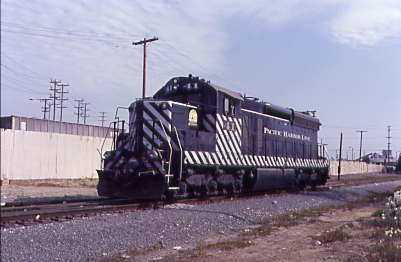
We drove to Wilmington where I caught Pacific Harbor Line SD18R 41, ex. Precision National Corporation 1837, exx. Precision National Corporation SD24 6337, exxx. Chicago and North Western 6638, exxxx. Southern 6337, nee Southern 2518 built by Electro-Motive Division in 1959, running light.
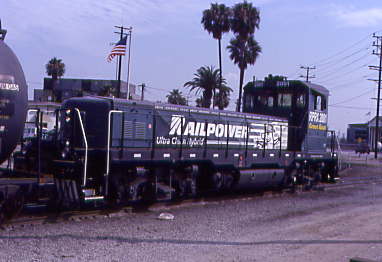
We went over to the PHL Pier A Yard catching the Railpower Technologies "Green Goat" 2001 at work. This was the concept locomotive which uses all batteries for power and has a small engine that recharges the batteries. It was built from Willamette Valley Railroad GP9 2890 which was originally Southern Pacific 2890 built by Electro-Motive Division in 1959.
We then drove over to San Pedro and went to Marina station where the car tent was located and in a trailer, David L. Garcia of Herzog Transit Services Inc., gave us a nice interview about the project and the cars. From there we drove to the Port O'Call station where we found the two Red Cars getting ready to attend the opening ceremonies and the two of us managed to get aboard 501 for the trip over. What a fantastic job the employeed did building this car as it is extremely impressive both inside and out. 1058 ahead of us and our 501 were both carrying the VIP's and once on the move, we followed it to the Downtown Station at 6th and Harbor Drive. After everyone had disembarked from 1058 and it pulled forward, it was our turn to pull in to the cheers of the crowd and the rolls of the drums.
The Opening Ceremonies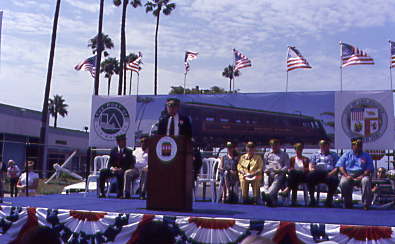
The ceremony started at approximately 11:25 AM with the Pledge of Allegiance then the remarks started with Bob Henry mentioning that Richard Fellows "restored" the 1058 car in the 1960's. It had been mounted on tandem truck axles and used around the port area like a bus. Mr. Henry then introduced Lois Fellows, who was in the audience. City of Los Angeles Deputy of Operations Mayor Don Lui thanked the Harbor Department on behalf of Mayor Jim Hahn, followed by Los Angeles City Councilwoman the Honorable Janice Hahn from District 15, the harbor area. She spoke of the past and future for the harbor. The late Kenneth Hahn, father of Mayor Jim Hahn and Janice Hahn, took them for a ride on the last day's Red Car Service from Long Beach to Los Angeles in 1961. Hahn then spoke of the future grand redevelopment of the port area and another restored piece of the past is the Cabrillo Bathhouse. Janice Hahn then honoured Bob Henry and 4th District Los Angeles City Councilman Tom LeBonge with an award.
The next speaker was Tom LeBonge, who mentioned that the redevelopment of the port will stretch from the Vincent Thomas Bridge to the breakwater. Betty Karnette, 27th District State Senator, was the following speaker and told the audience that she too grew up in Southern California and rode the Red Cars. Debra Bowen, State Senator 28th District, informed those gathered of the amount of paperwork involved in getting the Red Cars back on track and running. Several of the speakers started a running joke by saying that lots of paperwork was required by Sacramento, whoops, San Francisco, where the California State Public Utilities Commission is located.
Tom Warren, Harbor Commissioner, also spoke of the bridge-to-breakwater plan which will feature a promenade, with the plan due in 2004. Leslie Smith of the San Pedro Chamber of Commerce said a few words and the last speaker was Larry Keller, Port of LA Executive Director, who acknowledged the Harbor Commission. This finished the dedication ceremony and then public rides commenced.
Now for the RideWe reboarded Car 501 and we rode back to Ports O'Call where most of the VIP's left and we picked up a few more passengers then proceeded beneath the bluffs to the west and passed the car tent to the Marina Station, where a connection to the rubber-tired trolley could take you to the Cabrillo Aquarium, Cabrillo Beach and the Cabrillo Fishing Pier. The operator reversed the trolley poles and the passengers flipped the seats then we continued north, back by Ports O'Call and stopped there before running along Harbor Drive to the Downtown Station back at 6th and Harbor Drive, where one could transfer to the rubber-tired trolley line through Historic Downtown San Pedro. This is also the stop for the Los Angeles Maritime Museum.
1058 was sitting on the passing track as we boarded more passengers from the long lines which had formed then travelled north after passing 1058 by the large parking lots used by the cruise ship passengers' cars and continued north along Harbor Drive. We stopped at the World Cruise Center Station with the Vincent Thomas Bridge just to the north then repeated the pole-changing and seat-flipping ritual. After a prolonged wait to let 1058 return to near the Downtown Station, we travelled south to the passing track and ducked into it. 1068 only had one door so it took longer to load and unload than 501 with its two doors. Once 1058 passed us, we pulled into the Downtown Station where Richard, as well as most of the passengers, detrained, but I stayed on to get back to my car at Ports O' Call. I thanked the crew for a most wonderful experience.
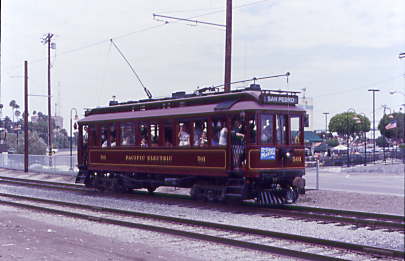
I set up for a runby of 501 as it made its way back to Marina Station.
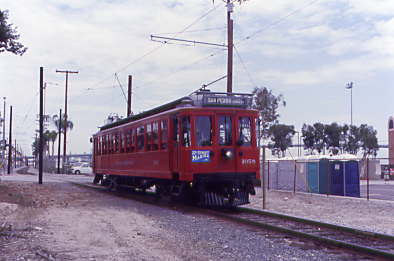
Once that was finished, I drove to opposite the Downtown Station and arrived in time to see 1058 going into the passing track. I picked up my Press kit before finding Richard in the crowd then talked briefly with Ken Ruben and found my good friend Barry Christensen photographing the arrival of 1058 into Downtown Station.

I dropped Richard off in Long Beach before I returning home to Santa Ana, ending a very interesting day of riding and learning about the San Pedro Waterfront Trolley. A special thank you to all the people who made this day possible and to Richard Elgenson for most of the opening ceremonies material.
| RETURN TO THE MAIN PAGE |